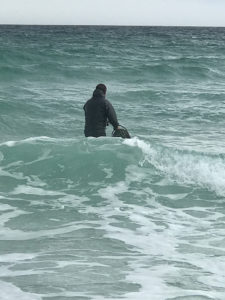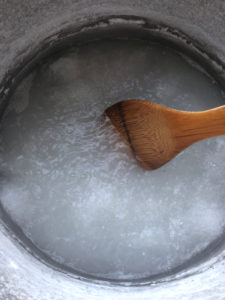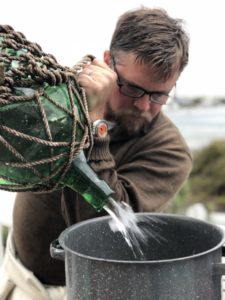A Good Salty Sea
Here at Aquala, we make things. We take nothing, like sheet rubber and a few molded components, and turn it into something, like a fully functional diving suit capable of diving as deep as humanly possible. If we don’t make it, we seek out other Americans who do. It’s what we are, we’re a network of makers. As the head of Aquala, that makers mindset doesn’t just stop at the workshop doors, it meanders through all parts of my life. Whether it’s planting vegetables and herbs around the yard, churning butter in a Mason jar, spearfishing in the Gulf of Mexico, hunting deer on the family farm, or making four-course meals from scratch, nothing gives me a greater sense of satisfaction than making or providing for the family. It runs through me, just as it ran through my grandfather, his father, and many grandfathers before.
As odd as it might sound, when I travel to the Florida Gulf coast, I can’t help but take advantage of the crystal clear turquoise waters and cook up a batch of sea salt to use around the kitchen. After all, there’s a whole ocean of it out there just free for the taking. Why not gather it when it’s lapping at your feet? Plus, I imagine there’s something far back in the genetic recesses of my mind that also inspires the thought.
Clearly, history and heritage are important to me, and that’s what drew me to Aquala back in the year 2000. Family history can’t be overlooked either. While going through the handwritten accounts of my family’s past, I came across one account from shortly after the American Civil War. During the war, most of my family was from the Carolinas, but after the war, they moved further south to escape their war-ravaged homes. There were deep parts of the south, like Louisiana and Florida, that hadn’t been as affected. Florida was their first move toward starting a new life.
Things after the war were scarce. The North had looted and burned most of the South’s resources, forcing survivors to become resourceful. Hunting, gathering and scrounging became a way of life. It had to be, for if you didn’t, you died. One thing necessary for survival was the procurement of salt. Salt was crucial for the curing and preserving of meats and fish, and they began making their salt by taking buckets to the shore and filling them with seawater from the Atlantic. Those buckets were then poured into large iron pots, and the sea salt was rendered over open fires on the sand. For them the endless bounty allowed them to cure the foods needed to further push west, the westward push that would eventually lead them to Louisiana in 1874. I know making sea salt sounds odd, but at least I come by it honestly.
Being here in Shreveport, Louisiana we’re undeniably landlocked. However, with a day of driving to spare, I can be on the Florida Gulf coast where I spent many a summer day as a child. That’s where sometime around the age of 3 I first discovered the ocean, and my love of diving began. Those were the mid-1970s, during the Golden Age of scuba, when the sport was still relatively new, and there seemed to be a dive shop on every corner. I would beg my father to take me to those shops, so I could have a look around. Watching the double-hose clad diver at the Gulfarium aquarium was always the highlight of my summer. Those are the childhood memories of which I cherish the most, and that’s what has kept me returning to those white sandy beaches for over forty years.
With our kids spending time away from home recently, my wife and I found that we had a long weekend to spare, so we loaded up the truck and headed east. Within a few hours, we were back at the shore, and I knew before we left that I needed to make a batch of salt. However, there’s slightly more to it than just dipping your pail, especially around this time of year.
March in that stretch of Florida is cool, but the Gulf waters are still cold from winter. Not Pacific cold, or North Atlantic cold, but still fairly cold to this native-born Southerner. Cold to the point that I couldn’t simply go in wearing a pair of trunks. I had brought along my Coronado suit, so I put it to use for what it does best…keeping me warm and dry. Late winter and early spring also bring higher surf. In order to get the good water, the water not so churned with sand, you need to wade out a bit. If not, your salt batch ends up gritty and nobody likes a sandy meal.
 Once the jug is filled, it’s back to the house to fire up the camp stove out on the porch. It takes a little longer this way, but when I used to cook it inside on the stove, the salty steam reacted with the stainless steel range hood. The next time we returned, the entire hood was one solid sheet of rust. But, there’s nothing wrong with sitting on the porch and listening to a rolling boil. It gives one time to think and enjoy a nice cold beer.
Once the jug is filled, it’s back to the house to fire up the camp stove out on the porch. It takes a little longer this way, but when I used to cook it inside on the stove, the salty steam reacted with the stainless steel range hood. The next time we returned, the entire hood was one solid sheet of rust. But, there’s nothing wrong with sitting on the porch and listening to a rolling boil. It gives one time to think and enjoy a nice cold beer.
Sure we could buy salt at the store, but it’s the process that makes it worthwhile. It’s the satisfaction of creating something useful and that also has strings to our past. The same goes for all that we do around here at Aquala. We make things because that’s what we do, and we hope you appreciate our finished product as much as we enjoy making it. After all, we take a whole lot of nothing and turn it into a little bit of something.
Ty Alley

Where are the crawfish??